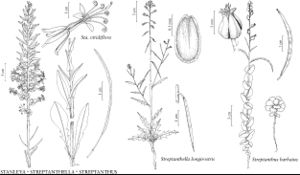Difference between revisions of "Stanleya viridiflora"
in J. Torrey and A. Gray, Fl. N. Amer. 1: 98. 1838.
FNA>Volume Importer |
FNA>Volume Importer |
||
| Line 23: | Line 23: | ||
|elevation=1300-2700 m | |elevation=1300-2700 m | ||
|distribution=Calif.;Colo.;Idaho;Mont.;Nev.;Oreg.;Utah;Wyo. | |distribution=Calif.;Colo.;Idaho;Mont.;Nev.;Oreg.;Utah;Wyo. | ||
| − | |discussion=<p>Stanleya collina M. E. Jones is an illegitimate name that pertains to S. viridiflora.</p> | + | |discussion=<p><i>Stanleya</i> collina M. E. Jones is an illegitimate name that pertains to <i>S. viridiflora</i>.</p> |
|tables= | |tables= | ||
|references= | |references= | ||
| Line 47: | Line 47: | ||
|publication year=1838 | |publication year=1838 | ||
|special status= | |special status= | ||
| − | |source xml=https://jpend@bitbucket.org/aafc-mbb/fna-data-curation.git/src/ | + | |source xml=https://jpend@bitbucket.org/aafc-mbb/fna-data-curation.git/src/8f726806613d60c220dc4493de13607dd3150896/coarse_grained_fna_xml/V7/V7_1207.xml |
|tribe=Brassicaceae tribe Thelypodieae | |tribe=Brassicaceae tribe Thelypodieae | ||
|genus=Stanleya | |genus=Stanleya | ||
Revision as of 18:54, 18 September 2019
Perennials; (caudex simple, covered with persistent petiolar remains); (glaucous), glabrous throughout. Stems erect, unbranched or branched distally, (2.5–)4–12(–14) dm. Basal leaves: petiole 2–10(–16) cm; blade lanceolate to oblanceolate or ovate, (2.2–)5–18(–22) cm × 10–40(–60) mm, margins often entire, sometimes dentate, rarely lyrate-pinnatifid. Cauline leaves sessile; blade lanceolate, (2–)3.5–8.5(–11) cm × (2–)5–19(–28) mm (smaller distally, base auriculate to sagittate), margins entire. Racemes loose. Fruiting pedicels horizontal to divaricate-ascending, 4–9(–12) mm. Flowers: sepals oblong-linear, 12–18 mm; petals whitish to lemon yellow, narrowly oblanceolate, 13–20 × 1–3 mm, claw 7–11 mm, (nearly linear-lanceolate), slightly wider at base, (margins usually erose, rarely subentire and crisped); filaments 11–20 mm; anthers 3.5–6 mm; gynophore (6–)11–22(–25) mm. Fruits divaricate or descending, curved inward, (torulose), subterete, 3–6(–7) cm × 1.2–2 mm; ovules 28–50 per ovary; style 0.04–0.3 mm. Seeds oblong, 2–3 × 1–1.2 mm. 2n = 28.
Phenology: Flowering May–Jul.
Habitat: Sagebrush and pinyon-juniper communities, limestone shale and rocks, red sandstone slopes, volcanic rocky slopes, clay knolls, steep bluffs
Elevation: 1300-2700 m
Distribution

Calif., Colo., Idaho, Mont., Nev., Oreg., Utah, Wyo.
Discussion
Stanleya collina M. E. Jones is an illegitimate name that pertains to S. viridiflora.
Selected References
None.
